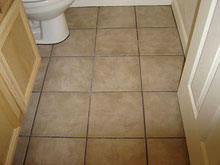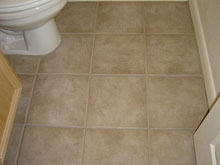TILE & GROUT MAINTENANCE
TILE & GROUT MAINTENANCE
Overtime, the look of your tile will begin to lose its luster due to everyday use. Nothing makes your floors look older than a dull finish and dark grimy grout.
The three main things that cause dirty grout in Arizona are:
- Dust
- Dirt
- Household spills
As dust and dirt accumulate on the floor and gets wet with mopping, the result is a fine slurry that gets stuck in the micro pores of unsealed grout or adheres to the surface of standard grout seals. This is most noticeable in high traffic areas, as light-colored grout begins to darken.

UNSEALED GROUT

GROUT AFTER CLEANING & SEALING
Removing Dust & Dirt:
To counteract these culprits, regular sweeping, dust mopping or vacuuming is recommended. Standard kitchen brooms work well to remove most dirt, but it usually leaves behind the dust. Using a good untreated dust* mop or the new static-cling dusters will remove most dust and dirt. However, some dust may be left in the grout because it is slightly lower than the tile’s surface. Take extra care to ensure dust and dirt do not remain in the grout. Vacuuming is another good way of ensuring your tile and grout are free of dust. The vacuum needs to have a good filtration system so the dust does not return to the floor. Also, make sure it is on a hard floor setting. Note, a standard carpet vacuum with a rotating brush may damage the grout. However, if your grout is level with or above the tile, vacuuming may damage it and any seal on the grout as the wheels or the underbelly of the vacuum scrape across it. In these situations use only a dust mop.
Household spills should be cleaned up immediately. If not, spills may stain the grout. Substances such as coffee, wine, grape juice, etc., almost always stain unsealed grout and will stain standard sealed grout if allowed to sit for very long. Most penetrating sealers on the market today, even the expensive ones, only provide stain resistance, meaning you have a little more time to pick up a spill. Sealing grout with these types of seals won’t make it stain proof. So clean up spills quickly.

Mopping floors with unsealed grout:
Mopping floors with unsealed grout should be kept at an absolute minimum. As indicated above, it is important to use only slightly damp mops or towels that leave no excess water (use water only). Unsealed grout is very porous, meaning that liquids will absorb into it quickly. You will notice unsealed grout will turn darker when it gets wet, which is the result of water entering the pores of the grout. Any dust or dirt in your mop water, on your mop, or on the floor may be sucked into the grout with the water. It will not be long before the grout starts to darken. Never pour water or cleaners directly on your floor. If you feel a cleaner is necessary, use one labeled with a neutral pH level which is a pH of 7 on a 14-point scale. If you have a lot of traffic on your tile or you feel it needs to be mopped more often, it should be sealed.
If this is the type of seal on your grout, follow these steps:
Sweep loose dirt and debris from the floor using a dust mop. A floor vacuum may be used but take care to ensure the wheels of the vacuum do not damage the seal.
Add pH neutral cleaner to mop water as recommended on the bottle.
- Apply the solution to a 10 square foot area to be cleaned.
- Allow the solution to sit for a couple minutes.
- Agitate cleaner on floor with a soft mop. Do not aggressively scrub.
- Mop dirty solution from the floor thoroughly and rinse with clean water and mop.
- Dry puddled water from the grout joints using a terry cloth towel.
Mopping floors with sealed grout:
There are two types of grout sealing. The first is called a penetrating seal. The penetrating seal is usually a clear liquid and it seals the pores of the grout. When water is applied to a properly sealed grout with penetrating seal, it will not change the color of the grout immediately. However, if left for a time it will usually absorb through the seal. As mentioned above these penetrating sealers only provide stain resistance. Over time these types of sealers will darken and need to be professionally cleaned or stripped and resealed.
If your floor is sealed with a penetrating seal, after dust mopping as explained above, mop your floor with a damp (not wet) mop. After mopping the floor, wipe up any excess water with a dry towel. Pay close attention to the grout lines. In almost all situations, if water is left on the grout it will have some level of dirt and over time will adhere to the seal and make the grout darker.
The second type of seal is a specialized stain seal. It is a new level of protection that can be achieved using a specialized sealing process. It blocks all spills from staining, lasts for many years and is easy to clean. Ceramic tile with this new seal may be maintained using a neutral pH tile and grout cleaner. Harsh cleaners like bleach, ammonia and vinegar should be avoided and can damage the grout or the seal. Any floor cleaner that states it is pH neutral will work. Cleaners that are pH neutral are specially formulated for use on protected ceramic tile and grout.
We recommend untreated dust mops because the oils in standard dust mops may damage the grout. There are a few newer dust mops that are not treated with oil-based chemicals. These may be safe to use. To be sure you’re always using the safest products for your floors, we carry the proper cleaning kits available for sale.
Contact us at (623) 878-7788 for a free estimate.
RESOURCES
Our Services Overview
Maintenance Tips
Testimonials
Coupon Specials
Contact Us

CONTACT INFO
All Stone, Tile & Wood Restoration
Glendale, AZ 85304
Phone: (623) 878-7788